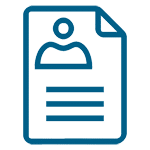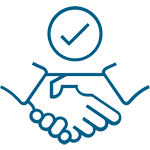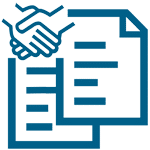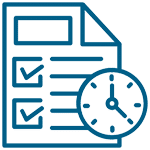Mentoring Process
All potential participants must complete the online orientation and register through the ASFPM Mentoring Program website before they are recognized as formal mentoring participants and can engage in active mentoring. Participants may become ineligible to participate if they do not follow mentoring process as described below. Ineligible activities could include providing incorrect information, being consistently unavailable or non-responsive, or receiving consistently poor evaluations.
STEP 1: Orientation.
 Orientation is the initial step for anyone interested in becoming a mentee or mentor and is required prior to registration. Orientation sets the correct expectations for the program, clarifies roles and responsibilities, explains the mentoring process, describes the resources available to participants, and helps provide a foundation for successful partnerships. Potential mentees and mentors (“applicants”) should set aside 60 minutes to complete the orientation on the website. Orientation can be completed in one of two ways, a video orientation or by reading the PDF version of the ASFPM Mentoring Program Handbook (PDF Handbook). The video orientation has been divided into six (6) shorter video segments so applicants can split the 60 minutes up as best fits their schedule.
Orientation is the initial step for anyone interested in becoming a mentee or mentor and is required prior to registration. Orientation sets the correct expectations for the program, clarifies roles and responsibilities, explains the mentoring process, describes the resources available to participants, and helps provide a foundation for successful partnerships. Potential mentees and mentors (“applicants”) should set aside 60 minutes to complete the orientation on the website. Orientation can be completed in one of two ways, a video orientation or by reading the PDF version of the ASFPM Mentoring Program Handbook (PDF Handbook). The video orientation has been divided into six (6) shorter video segments so applicants can split the 60 minutes up as best fits their schedule.
Upon completion of the orientation, participants should be able to:
- Understand the self-directed mentoring process (i.e., registration, mentoring requests, mentoring agreements, action plans, monitoring and evaluation)
- Understand the four mentoring approaches
- Understand the role and responsibilities of the mentee and mentor
- Access mentoring resources and tools
Links to the orientation training are provided on the mentee and mentor registration webpages and forms.
Please note that after their initial orientation, mentees and mentors who remain engaged and active in the program will be notified by the program manager(s) of any substantial changes to the program and whether or not those changes require them to renew their orientation.
STEP 2: Registration.
 After completing the online orientation, applicants should register a username and password for the program website and then create a mentee or mentor profile as prompted. With the exception of the username which cannot be changed once submitted, all information submitted to a profile at time of registration can be edited on the profile page later. Participants are asked to keep their profile information up-to-date.
After completing the online orientation, applicants should register a username and password for the program website and then create a mentee or mentor profile as prompted. With the exception of the username which cannot be changed once submitted, all information submitted to a profile at time of registration can be edited on the profile page later. Participants are asked to keep their profile information up-to-date.

Forgotten usernames and passwords can be reset using the “Lost your username or password?” link on the login page. Enter your username or email address to receive an email from the Flood Science Center containing your username and a link to reset your password.
Currently, registering as a mentor or mentee in the program is mutually exclusive per unique email address. Over the course of a career, participants may wish to transition from mentee to mentor, and veteran mentors may wish to seek mentorship guidance. Switching a participant's role is possible with assistance from the program manager(s) or by using a separate unique email address, profile, username, and password.
Registered users can select “Log In” from the navigation menu and enter a username and password to access their profile on the website.
Mentee Registration
To enroll in the program, would-be mentees can register on the Register as Mentee page on the ASFPM Mentoring website. For assistance with the Mentee Registration process, see page 9 of the PDF Handbook.
Mentor Finder
 Once registered, mentees can use their Profile Page to browse the Mentor Finder, submit mentoring requests, and manage any submitted mentoring applications and/or questions sent via Ask a Mentor. ASFPM developed the Mentor Finder as the method for mentees to search for and locate the best mentor for each topic area, issue or mentoring type.
Once registered, mentees can use their Profile Page to browse the Mentor Finder, submit mentoring requests, and manage any submitted mentoring applications and/or questions sent via Ask a Mentor. ASFPM developed the Mentor Finder as the method for mentees to search for and locate the best mentor for each topic area, issue or mentoring type.
The Mentor Finder is a directory of approved subject matter experts who have completed the orientation and registration process. Mentees can access additional mentor profile information by clicking the mentor’s name or picture in the Mentor Finder. Mentees narrow the search for an appropriate mentor by filtering mentors by areas of expertise, state, FEMA region and available mentoring format(s). Mentees use this method when selecting a preferred mentor for a mentoring request or when using Ask a Mentor.
Mentor Registration
Mentors should be ASFPM members with relevant subject matter expertise, sufficient availability and a minimum of five years of practical experience. Would-be mentors can register on the Become a Mentor page on the ASFPM Mentoring website. For assistance with the Mentee Registration process, see page 11 of the PDF Handbook.

Mentor registration needs
Please note additional time may be needed to collect and produce the necessary materials to complete the mentor profile section of the registration form which must contain: contact information, years of professional floodplain management or hazard mitigation experience, areas of expertise, participating types of mentoring, a professional biography focusing on subject matter expertise and a headshot image, as described below.
Would-be mentor applicants must be approved by the program manager(s). Mentor registrations are reviewed against the eligibility criteria as well as general criteria for successful partnerships (e.g., expertise, experience, location, commitment and agreement to abide by the process). The program manager(s) will contact applicants via email within a few days indicating approval or rejection to the program. In rare cases, the program manager(s) may give written approval on a case-by-case basis if a mentee or mentor does not meet all of the eligibility criteria. Any applicant deemed ineligible will be notified by the program manager(s) in writing and provided a reason (e.g., mentee not actively employed by a state, or mentor with insufficient related subject matter expertise).
Once approved and registered, mentors are listed in the Mentor Finder. Mentors can use their profile to toggle their current status between “Available” and “Unavailable” based in their schedules. Mentor profiles are accessible from the Mentor Finder while their status is set to “Available;” a mentor set to “Unavailable” will not be displayed in the Mentor Finder.
Mentors are expected to keep their profiles updated with current information and status. The program manager(s) may contact any mentor who has been inactive for more than 12 months and request they update their interest and availability status. If a mentor does not respond or remains "unavailable" for engaging with mentees, they may be removed from the approved mentor pool.
STEP 3: Requesting a mentor.
 Every mentoring request will be unique to each mentee’s situation and should be as specific as possible to ensure the mentee is assigned the best mentor to fit their request and lead to a successful mentoring pairing. For examples of the types of and topics for mentoring requests that mentees may make, mentees can consult the Activities & Learning Opportunities and Knowledge Areas subsections of the Resources and Tips for Building Successful Partnerships section (page 24 of the PDF Handbook) - or contact the program manager(s).
Every mentoring request will be unique to each mentee’s situation and should be as specific as possible to ensure the mentee is assigned the best mentor to fit their request and lead to a successful mentoring pairing. For examples of the types of and topics for mentoring requests that mentees may make, mentees can consult the Activities & Learning Opportunities and Knowledge Areas subsections of the Resources and Tips for Building Successful Partnerships section (page 24 of the PDF Handbook) - or contact the program manager(s).
Mentees initiate the mentoring process by submitting the Request Mentoring Form found on their My Profile page. (Please note that mentees do not submit a mentoring request for Ask a Mentor; they are instead directed to the Mentor Finder into which the Ask a Mentor functionality is built.)
After choosing one of the Mentoring Approaches described in the following subsection, the relevant questions for the format chosen appear on the page. Find a copy of the Request Mentoring Form for One-on-One Mentoring in Appendix D of the PDF Handbook.
Mentoring Program Approaches
ASFPM’s Mentoring Program delivers learning opportunities and activities through four types of mentoring.
One-on-One Mentoring
 One-on-one is the traditional method of mentoring, in which an experienced mentor shares knowledge, skills and insight with a less experienced mentee.
One-on-one is the traditional method of mentoring, in which an experienced mentor shares knowledge, skills and insight with a less experienced mentee.
The partners mutually agree on the goal(s), expectations, planned activities, frequency of exchanges and duration of the partnership. A mentoring agreement captures these items and any ground rules for the partnership. Learning is supported through training, practice and feedback using the ASFPM Mentoring Program framework. This method of mentoring works best when the mentee is seeking personal attention or guidance.
For example, a new state NFIP coordinator may be overwhelmed by the scope of floodplain management program activities they must manage and have no in-state program or tenured staff to assist. An experienced state NFIP coordinator can provide the new professional with access to resources and a basis for decision-making.
Group Mentoring
 Group mentoring is when one or more subject matter experts with experience are matched with several mentees for an activity or learning opportunity as a mentor or mentoring team.
Group mentoring is when one or more subject matter experts with experience are matched with several mentees for an activity or learning opportunity as a mentor or mentoring team.
In this approach, the mentor(s) facilitate instruction, guidance and discussion of pre-identified topics based on mentees’ needs. Mentees can also engage in mentoring one another in this format if their level of knowledge or skill varies. A mentoring agreement is used to capture expectations and goals for the exchange. This mentoring method works well when several mentees have a similar mentoring goal. It best lends itself to promoting peer learning and strengthening professional relationships.
Typically, rather than being requested by an individual mentee in hopes of being added to a group of other individual mentees with like needs, this mentoring approach would be requested by an individual mentee who signs up to request mentoring on behalf of their department or a group of people within their department.
For example, a state NFIP coordinator may wish to develop competency in new or additional staff to support their floodplain management program activities. The mentor(s) deploy, in a group setting, one or more training modules that reflect the skills, knowledge, abilities or behaviors that a state NFIP coordinator and their staff should possess. This training is delivered to the group while mentor(s) engage mentees by discussing the content of the modules. The learning is individualized rather than taught with a generic set of objectives. The course can be delivered as a comprehensive effort addressing all 14 modules or specific modules selected by the state.
Another variation of group mentoring is sometimes referred to as flash or speed mentoring. This approach allows mentors with valuable knowledge, but limited time, to participate in short (30-60 minute) one-time exchanges.
For example, at the ASFPM annual national conference, potential mentees and mentors are invited to attend a session in which mentors share experiences, best practices and advice on pre-chosen topics. For each session, the mentor outlines a purpose, expectations and guidelines for the process. Participants in flash/speed mentoring should be provided information on the complete mentoring program.
Situational Mentoring
 Situational mentoring is for mentoring in time-sensitive situations (e.g., help dealing with a disaster declaration for the first time).
Situational mentoring is for mentoring in time-sensitive situations (e.g., help dealing with a disaster declaration for the first time).
This method allows ASFPM to meet a mentee's need for guidance and advice in a timely manner. Situational mentoring is often described as "the right help at the right time." This type of mentoring is characteristically short-term (but may lead to long-term partnerships) and focused on an immediate need or specific problem. The mentor, a subject matter expert with experience and insight, builds the mentee's confidence and competence through guidance and advice. A mentoring agreement is used to capture expectations, goals and ground rules for the exchange.
If you require immediate or time-sensitive assistance, please select Situational Mentoring for your mentoring request or contact the program manager(s).
Ask a Mentor
 Ask a Mentor delivers quick, trusted feedback and advice on a specific question to a specific mentor through the program website. Answers are delivered to the mentee’s email inbox.
Ask a Mentor delivers quick, trusted feedback and advice on a specific question to a specific mentor through the program website. Answers are delivered to the mentee’s email inbox.
Ask a Mentor is a simple method for allowing colleagues to help one another. It provides a mechanism for participants to ask questions, share strategies, explore best practices and discuss relevant topics – creating a sense of community and a professional network for sharing knowledge.

Two important notes about Ask a Mentor:
- Mentees are asked use the Ask a Mentor functionality built into the Mentor Finder instead of contacting mentors directly, unless there is a previous relationship.
- Mentees should only send Ask a Mentor questions to one mentor at a time. Should the mentee receive no response within three business days, then another request may be sent. If the response is time sensitive, the program manager(s) may assist to find another active mentor.
The Ask a Mentor functionality is built into the Mentor Finder. Mentees use filters to find a subject matter expert, then click on the “Ask a Question” button displayed on participating mentor profiles. Mentees must be logged into the website for the Mentor Finder and “Ask a Question” buttons to be visible.
When a mentee submits an Ask the Mentor question, an email is sent to the mentor with instructions to either answer the question or alert the mentee that they will need to ask a different mentor due to a knowledge gap or time constraints. Mentors are asked to reply-all to Ask a Mentor exchanges so that the program manager(s) can compile a list of Common “Ask a Mentor” Questions (as found in Appendix E).
Mentors are invited to respond based upon experience and subject matter knowledge. Mentees must understand that any advice given is not prescriptive and that there may be a variety of perspectives shared by responding mentors.
Neither a mentoring agreement, action plan, nor partnership log is necessary when using Ask a Mentor.
STEP 4: Mentor matching and assignment.
 Mentor matches will be based upon the mentor's expertise relative to the mentee's area of need and the selected mentoring approach.
Mentor matches will be based upon the mentor's expertise relative to the mentee's area of need and the selected mentoring approach.
Mentees can select a preferred mentor by using the Mentor Finder filters and entering the mentor’s name into the Request Mentoring form. Although every attempt will be made to respect a preferred mentor designation when requested, the program manager(s) may choose to assign another mentor if: the selected mentor is not available; a mentee needs significant assistance in identifying their development needs; a mentee has been referred (e.g., new state NFIP coordinator); a mentee has a time-sensitive need; or specific mentor expertise is critical to partnership success. Whenever possible, partners will be assigned from within the same FEMA region. If a mentee does not request a preferred mentor, the program manager(s) will assign the best mentor available based on the mentees request.
The program manager(s) will contact mentors before assigning them a mentoring request. Mentors will have the option to refuse a partnership proposal.
ASFPM's policy is that for the one-on-one mentoring and Ask a Mentor formats, each mentor will work with only one mentee at a time. For group and situational mentoring formats, more than one mentor and/or mentee may engage in the relationship. Any circumstance requiring a mentor to support more than one mentee at a time must be approved by the program manager(s).
STEP 5: Establishing your mentoring partnership.
 Upon a match being made, the program manager(s) will send the mentee and mentor partners a welcome email that contains a welcome packet and key templates to fill out and return to the program manager(s). After the program manager(s) sends this introductory email, a mentoring request becomes a mentoring partnership, and the mentor is the lead in establishing the relationship with the mentee. Successful and rewarding mentoring partnerships begin by using the framework of concepts, documents and tools developed by ASFPM to facilitate the mentoring relationship as described below.
Upon a match being made, the program manager(s) will send the mentee and mentor partners a welcome email that contains a welcome packet and key templates to fill out and return to the program manager(s). After the program manager(s) sends this introductory email, a mentoring request becomes a mentoring partnership, and the mentor is the lead in establishing the relationship with the mentee. Successful and rewarding mentoring partnerships begin by using the framework of concepts, documents and tools developed by ASFPM to facilitate the mentoring relationship as described below.
The welcome packet contains the following information and documents:
Contact Information
The program manager(s) will populate the Contact Information in the welcome packet with the partner information. This document also lists the program manager’s contact info, as well as the date and topic/issue of the mentoring request. Partners should update their contact information as needed throughout their partnership.
Mentoring Partnership Checklists
The partners each have a to-do list to guide them through their mentoring process. As the partnership progresses, partners should check items off of their list as they are completed.
SMART Goals Worksheet Template
Specific → Measurable → Achievable → Relevant → Timely
 The ASFPM framework for mentoring uses good goals as the foundation for developing mentoring agreements, tracking progress and determining whether a partnership is successful. After formal introductions and each reading the welcome packet, the first thing for the partners to tackle is defining the goals of the partnership.
The ASFPM framework for mentoring uses good goals as the foundation for developing mentoring agreements, tracking progress and determining whether a partnership is successful. After formal introductions and each reading the welcome packet, the first thing for the partners to tackle is defining the goals of the partnership.
The partners should discuss the reasons and expectations for their mentoring partnership and develop one or more goals to drive their relationship. ASFPM suggests that mentees use the provided SMART Goals Worksheet to aid in defining partnership goals, with the Mentor’s assistance. Copies of Guidance for Creating SMART Goals and the SMART Goals Worksheet can be found in the welcome packet and in Appendix F of the PDF Handbook.
Once the partnership’s goals are developed, they should then be integrated into the Mentoring Agreement.
Action Plan Template
 Once the mentee and mentor have agreed to the goal(s) for the partnership, specific actions need to be identified to move the mentee toward their goal(s). Although the discussion may involve the mentee and mentor, creating the action plan is the responsibility of the mentee. ASFPM suggests that mentees use the provided Action Plan Template to aid in defining partnership goals. A copy of the Action Plan Template can be found in the welcome packet and in Appendix G of the PDF Handbook.
Once the mentee and mentor have agreed to the goal(s) for the partnership, specific actions need to be identified to move the mentee toward their goal(s). Although the discussion may involve the mentee and mentor, creating the action plan is the responsibility of the mentee. ASFPM suggests that mentees use the provided Action Plan Template to aid in defining partnership goals. A copy of the Action Plan Template can be found in the welcome packet and in Appendix G of the PDF Handbook.
If more than one goal has been identified, mentees should make an action plan for each goal.
Once the partnership’s action plan is developed, the actions should then be integrated into the Mentoring Agreement.
Mentoring Agreement Template
 Once the goal(s) and action(s) for the partnership have been identified, the partners should work together to develop their mentoring agreement. The mentoring agreement establishes the terms of the partnership and reflects the partners’ understanding of their goals for, boundaries of, and roles in the mentoring relationship. An ASFPM mentoring partnership cannot commence until the mentee and mentor complete a mentoring agreement. All of the mentoring formats except for Ask a Mentor require the completion of a mentoring agreement by the mentee and mentor. Please note, however, that the Group Mentoring Agreement, a copy of which is included in Appendix H of the PDF Handbook, is a truncated version of the agreement described below.
Once the goal(s) and action(s) for the partnership have been identified, the partners should work together to develop their mentoring agreement. The mentoring agreement establishes the terms of the partnership and reflects the partners’ understanding of their goals for, boundaries of, and roles in the mentoring relationship. An ASFPM mentoring partnership cannot commence until the mentee and mentor complete a mentoring agreement. All of the mentoring formats except for Ask a Mentor require the completion of a mentoring agreement by the mentee and mentor. Please note, however, that the Group Mentoring Agreement, a copy of which is included in Appendix H of the PDF Handbook, is a truncated version of the agreement described below.
As needed, the partners may ask the program manager(s) for assistance in developing their mentoring agreement.

Make sure to send a PDF of your completed mentoring agreement to the program manager(s).
The mentoring agreement is a fillable form in the Welcome Packet. Edit the mentoring agreement using the guidance above to answer the questions. Once complete, sign and save as a PDF, and send it to the program manager(s). The program manager(s) will then review the mentoring agreement, notify the partners if there are any issues, and, if there are no issues, file it in the program’s records.
The mentee and mentor should refer back to the agreement as necessary throughout the partnership.
Find a copy of the Individual Mentoring Agreement and Group Mentoring Agreement templates in Appendix H of the PDF Handbook and in the welcome packet.
STEP 6: Maintaining your mentoring partnership.
 ASFPM recommends the partners review the Resources and Tips for Building Successful Partnerships section (page 24 of the PDF handbook) together and keep up with the required monthly partnership logs.
ASFPM recommends the partners review the Resources and Tips for Building Successful Partnerships section (page 24 of the PDF handbook) together and keep up with the required monthly partnership logs.
The partnership log is a way to track progress on actions and share feedback about any changes needed to the partnership or action plan. The log is intended to improve interactions between mentee and mentor by providing regular feedback during the partnership. It is a tool for tracking progress on the planned activities and actions, gauging the compatibility of the relationship, and whether learning expectations are being met.
Submitting a Partnership Log
 For a successful mentoring program, monitoring must take place. The partnership log focuses on monitoring participants' satisfaction with the process and their mentoring relationship by asking a series of questions that are tailored to the mentee or mentor role. The program manager(s) will send around a reminder to complete the monthly Partnership Log on 1st of the month every month, throughout the duration of the mentoring partnership.
For a successful mentoring program, monitoring must take place. The partnership log focuses on monitoring participants' satisfaction with the process and their mentoring relationship by asking a series of questions that are tailored to the mentee or mentor role. The program manager(s) will send around a reminder to complete the monthly Partnership Log on 1st of the month every month, throughout the duration of the mentoring partnership.
The Partnership Log is completed and submitted through a link provided in the Welcome Packet. You will enter your name and role on the first page of the log. The next two pages ask participants to indicate how strongly they agree or disagree with statements regarding elements of their mentoring partnership. The final page asks about learning and development, and provides a comment area to freely discuss your partnership.
The mentee/mentor should reflect on their feedback and discuss whether changes are needed to improve progress and satisfaction. Any changes should be reflected in the action plan.
Please complete your first partnership log submission within two weeks of approval of a mentoring agreement. Submit partnership logs monthly for the duration of the partnership.
The program manager(s) should be consulted immediately with any unresolved issues or concerns and can provide copies of the partnership logs to the partners upon request. The program manager(s) may also step in to provide guidance if partnership issues arise in the submitted logs and will prompt partners to complete a log if they fail to do so. The program manager(s) has access to all submitted partnership logs.
Find copies of the Partnership Log in Appendix I of the PDF Handbook.
STEP 7: Closing your mentoring partnership.
 Partners may use a defined duration, achievement of goals and actions, or other defined criteria to determine when a partnership should end. In most cases, closure will occur when the goals and actions have been completed, and the partners agree the benefits of the relationship have been attained. The mentoring agreement includes a participant-defined closure.
Partners may use a defined duration, achievement of goals and actions, or other defined criteria to determine when a partnership should end. In most cases, closure will occur when the goals and actions have been completed, and the partners agree the benefits of the relationship have been attained. The mentoring agreement includes a participant-defined closure.
Mentoring agreements may be canceled and partnerships may be closed prior to completing the action plan if:
- either participant feels the exchange is no longer positive or providing benefit, or
- the program manager(s) recognizes that a partnership is not making progress or no longer valued by the participants.
This type of closure will be considered a "no fault" mutual dissolution and participants will be asked to share "lessons learned" so that future partnerships may be improved and early closures avoided.
Participants should alert the program manager(s) when a partnership has been closed. Upon closure, the mentoring partners are expected to complete a Partnership Evaluation concerning whether the experience was positive, the partnership met their expectations, and the desired goals were achieved. The program manager(s) will not be responsible for supporting and monitoring closed partnerships.
Closure of one partnership must occur prior to the partners entering another partnership unless approved by the program manager(s) (i.e., mentor involved in more than one partnership at a time, or use of Ask a Mentor within the mentoring partnership activities).
STEP 8: Program and partnership evaluation.
 It is expected that as the program is implemented, there will be opportunities for improvement that need to be identified. Participants input is essential to the process of building an effective mentoring experience for everyone. The Partnership Evaluation and Ask a Mentor Feedback forms focus on the broader program as well as partnership goal achievement. Feedback should identify any issues for improvement within the Mentoring Program.
It is expected that as the program is implemented, there will be opportunities for improvement that need to be identified. Participants input is essential to the process of building an effective mentoring experience for everyone. The Partnership Evaluation and Ask a Mentor Feedback forms focus on the broader program as well as partnership goal achievement. Feedback should identify any issues for improvement within the Mentoring Program.
All evaluation instruments will be emailed by the program manager(s). ASFPM may request additional training evaluation and feedback for specific mentoring learning and development activities via alternate verbal, written or online methods of monitoring and evaluation Over time, additional training and long-range evaluation tools may be developed as the program matures and expands.
Via these evaluation tools, the program manager(s) will monitor the satisfaction of participants and make program improvements to ensure that mentoring exchanges are positive and worthwhile to those involved.
Partnership Evaluation Form
The partnership evaluation form was developed to collect relevant information that can be used for decision-making as the program moves forward. It focuses on how well the partnership has accomplished the desired goals within the program framework.
The program manager(s) will send a link to the partnership evaluation when the partners agree the goals of their partnership have been met or that it is time to end the partnership (see the previous section, Closing a Partnership). The evaluation should be completed in a timely manner upon receipt from the program manager(s).
Find a copy of the Partnership Evaluation Form in Appendix J of the PDF Handbook.
Ask a Mentor Feedback Form
Ask a Mentor Feedback is collected in an online survey. The short survey captures each participant’s satisfaction with the experience and provides an opportunity for comment. The survey asks participants to indicate how strongly they agree or disagree with five statements regarding their Ask a Mentor experience.
The program manager(s) will provide the mentee/mentor with a link to access the feedback survey two weeks after submission of the Ask a Mentor question. Mentees/mentors are asked to complete the feedback survey within 1-3 days of receipt.
Find the Ask a Mentor Feedback Form in Appendix K of the PDF Handbook.